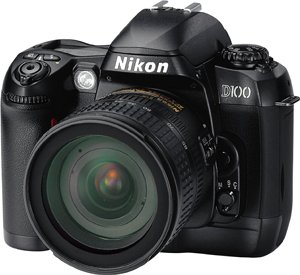articles/Cameras/nikond100-page1
Nikon D100 - part 1 of 1 2
by Mike McNamee Published 01/10/2002

Our original plan was to do a more in depth assessment of the S2 Pro and the D100. In the event the S2 has been a bit shy in appearing (now thankfully resolved!) and so a more leisurely analysis will have to be made. This is no bad thing, we think our readers deserve to hear how the cameras have performed in real situations before parting with their money. Others, however, are already convinced and have taken the plunge. It is unlikely from what we have seen so far that either camp is going to be disappointed.
FIRST IMPRESSIONS
The first impression of the D100 is that it is a handsome little beast, it has none of the bulging muscles of some of its more heavily specified cousins. The absence of chamber from which to spool film has enabled the engineers to shorten the left-hand side and still find enough space for the additional buttons that digicams need. All the requisite controls are very accessible and fall readily to hand. The double thumb wheel for exposure settings and the top-plate dial was particularly easy to follow; you don't feel like you are adjusting a wristwatch when you use the D100. It's so good in fact that we didn't use the manual at all to find our way about. There is however a really superb run-through of D100 operation on the Nikon web site. The viewfinder is bright and clear with a dioptre adjuster.

SPECIFICATION
You will find a detailed specification of the D100 on the Nikon website. The salient points are that this is a 6.3mpixel camera delivering a nominal 18MB RGB file.
The framing rate is 3fps and the burst depth is 6 with JPEG and 4 with RAW format. We measured the time to recover after a 6 frame burst. The camera allowed us to fire again after about 10 seconds but not with another burst, only a single image.
The shutter speeds run from 30s to 1/4000th s and the shutter is synched at 180th s. ISO speed equivalents are 200 to 6400. The scaling factor of the lens is 1.5x. This is a bonus at the telephoto end but you will need a 16mm lens to get the 35mm-format equivalent of a 24mm lens.
Studio flash synchronisation is achieved via an adapter (AS-15). Lens compatibility is to AF Nikkor, D-Type Manual Focus, Ai-P Nikkor. Non CPU is useable in manual mode but you lose auto metering (this is hardly a problem you should be using the Histogram anyway!).
You are currently on page 1 Contact Mike McNamee
1st Published 01/10/2002
last update 09/12/2022 14:56:58
More Cameras Articles
There are 0 days to get ready for The Society of Photographers Convention and Trade Show at The Novotel London West, Hammersmith ...
which starts on Wednesday 14th January 2026





